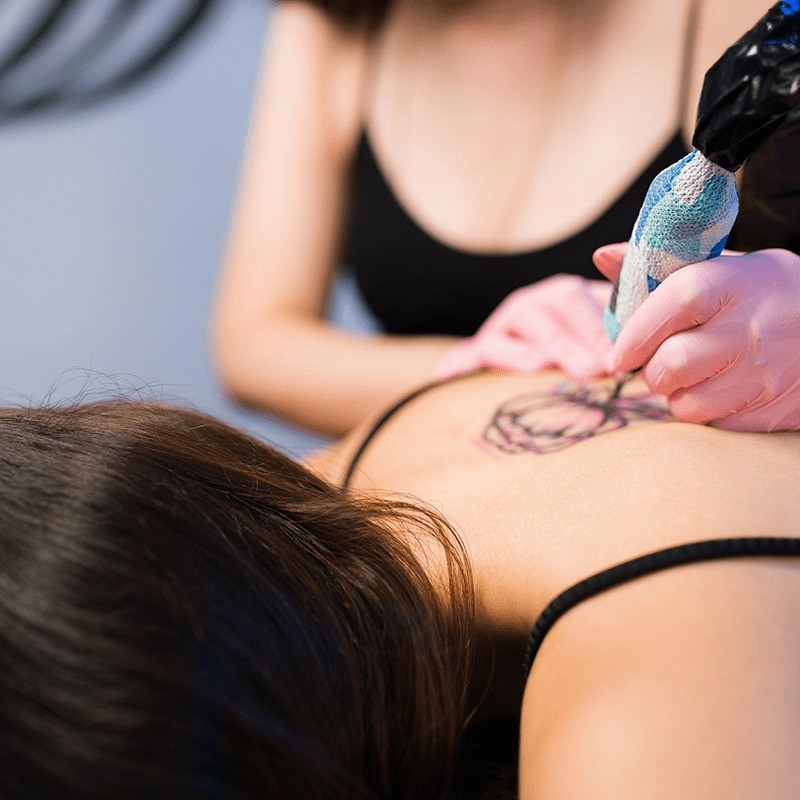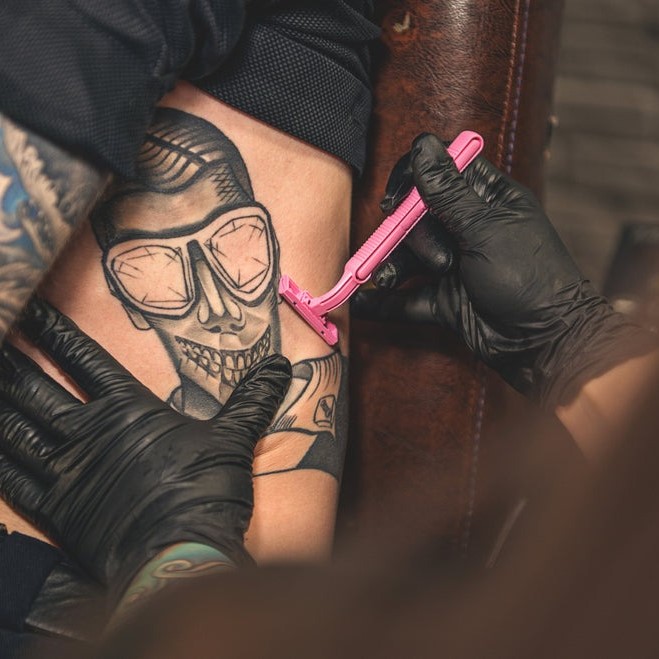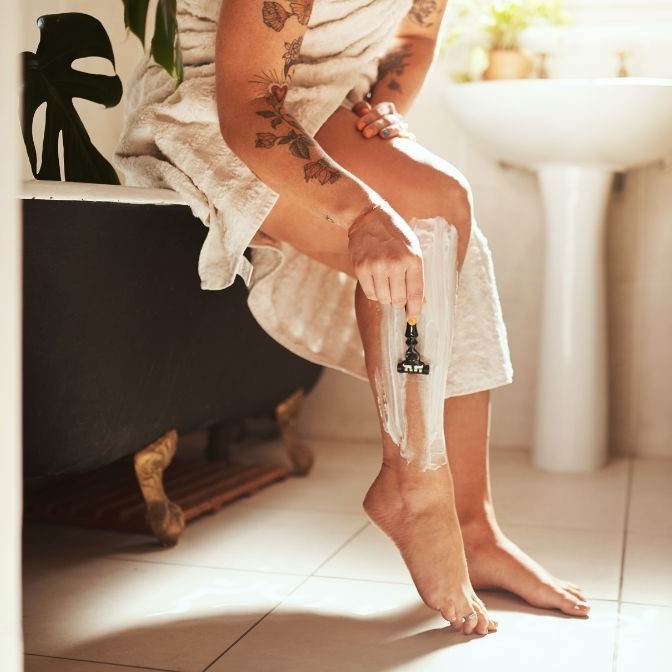Getting a tattoo is an exciting experience, but it comes with the responsibility of proper aftercare. One of the frequently asked questions by individuals after getting inked is, “When can I shave my tattoo?”
Understanding the importance of this question is crucial. Shaving too soon after getting a tattoo can lead to complications such as infections or damage to the tattooed area. Therefore, timing is everything.
Pre-Tattoo Preparation: To Shave or Not to Shave?
When planning for a tattoo, preparing your skin is key. One common question is about shaving. Should you shave the area before getting a tattoo? The answer is yes, mostly. A smooth canvas is crucial for the tattoo artist’s precision and to prevent infection.
Shave the area gently a day or so before your appointment. This reduces the risk of skin irritation. Don’t worry if you miss a spot; tattoo artists can handle any missed hairs. They often shave the area again as a precaution. Use a sharp razor to avoid nicks and be gentle to prevent razor burn.
If you have sensitive skin, consider shaving several days before. This will give any potential irritation time to subside. After shaving, avoid heavy lotions or oils. These can interfere with the tattooing process. Keep the area clean and dry for the best results.
Remember, pre-tattoo shaving is about safety and ensuring the best outcome. A properly shaved area can make the tattooing process smoother and help with the ease of inking. So, when the time comes for your next piece of body art, grab that razor and prep your skin right.
The Tattooing Process and Skin’s Reaction

When you get a tattoo, the needle creates tiny wounds in your skin. As the needle injects ink into the dermis, your body reacts as it would to any other injury. The area becomes red and may swell slightly. This response is your immune system at work, beginning the healing process.
Responding to the Ink
As the ink settles into the dermis, the second layer of skin, your body forms a protective barrier. This barrier traps the ink, making your tattoo permanent. During this time, the skin is sensitive. It’s important to follow aftercare instructions to avoid infection or damage to the tattoo.
Healing Stages
Your tattoo will go through several healing stages. The first is swelling and redness, followed by peeling and possibly itching. Scabs may form, and they should be left alone to heal naturally. Picking at scabs can remove the ink and leave scars.
The full healing process often takes a few weeks. During this time, it’s crucial not to shave the tattooed area. Shaving can interfere with the healing process and possibly remove the ink. Wait until the tattooed skin returns to its normal texture and the shine has disappeared. Only then is it safe to shave again.
Understanding the Healing Phases of a Tattoo
When you get a new tattoo, it goes through several healing phases. Understanding these phases helps you know when shaving is safe.
Initial Healing Phase
Right after getting tattooed, your skin starts to heal immediately. The area might be red, swollen, and tender. This is the body’s normal reaction to the tattoo needle’s work.
Scabbing and Peeling
Within a few days, scabbing or peeling often occurs. It’s the body shedding damaged skin. Shaving now can pull away scabs with ink.
Itchiness and Shiny Skin
Next, the tattoo may get itchy. It’s a sign of healing underneath the skin. The tattooed area may also appear shiny, which means it’s not ready for shaving yet.
Final Healing Stage
After a few weeks, your skin should return to its normal texture. The shine fades, indicating the tattoo has settled into the skin.
Once the tattooed skin feels just like the surrounding areas and has no more shiny or raised spots, you can shave. Wait for complete healing to avoid infection and keep your tattoo intact. Follow your tattoo artist’s advice for perfect healing.
Determining the Right Time to Shave Over Your New Tattoo
After getting inked, knowing when to shave is crucial for your tattoo’s health. Here’s how to determine the right time to shave over your new tattoo:
- Wait for Complete Healing: It typically takes about 2 to 3 weeks for a tattoo to heal fully. Be patient; don’t rush this process.
- Check the Texture: Once the tattooed area feels as smooth as the skin around it, it’s a good sign. Look for any scabs or bumps before choosing to shave.
- No Shine: A healed tattoo has no shine to it. If there’s shine, the skin is still healing.
- Listen to Your Artist: Your tattoo artist knows best. Follow their instructions on when to shave.
- Do the Touch Test: Gently touch the area with closed eyes. If you can’t feel the tattoo’s edges or raised skin, shaving is likely safe.
- Look Out for Itchiness or Peeling: If these signs are present, hold off on shaving. The skin is not ready yet.
- Avoid Irritation: Even when your tattoo seems healed, avoid shaving if the skin feels irritated.
Remember, when you think your tattoo is ready to be shaved, execute caution. Use a new, clean razor and a quality shaving gel or foam. Shave gently to protect your inked masterpiece. Keep your post-shave routine focused on caring for your skin and tattoo. Consider using products that nourish and protect the tattooed area.
Step-by-Step Guide: How to Safely Shave Over a Tattoo

Once your tattoo has entirely healed, follow these steps for a safe shave:
- Wait for Full Healing: Ensure no scabs, shine, or swelling is present. The area should feel like normal skin.
- Use a New Razor: Always start with a fresh, clean blade to minimize infection risks.
- Prep Your Skin: Soak the skin with warm water. This softens hairs for an easier shave.
- Apply Shaving Gel: Use a quality shaving gel or foam. It helps protect the tattooed skin.
- Shave Gently: Use light strokes to shave in the hair growth direction. Avoid going against the grain.
- Rinse with Care: After shaving, rinse the area with lukewarm water. Pat it dry gently.
- Apply Aftercare Products: Moisturize with products designed for tattooed skin.
- Look for Irritation: If you notice redness or discomfort, consider a soothing balm.
- Check Blade Sharpness: Replace your razor blade regularly. Dull blades can tug hairs and irritate the skin.
- Monitor Your Tattoo: If anything seems off, reach out to your tattoo artist.
Shaving over your tattoo can be safe if you’re careful and follow these steps. Keep your skin and tattoo in top condition with proper care.
Alternatives to Shaving During the Healing Process
While waiting for your tattoo to heal, consider these hair removal alternatives:
- Waxing Prior to Tattooing: Schedule a waxing session before getting inked. This can keep skin hair-free longer.
- Hair Removal Creams: Once healed, use creams instead of shaving. Be sure it doesn’t irritate the tattoo.
- Electric Trimmers: For a close trim without a blade, electric trimmers work well. Avoid touching the tattoo.
- Letting It Grow: Simply allowing the hair to grow can be the easiest option. It won’t affect the tattoo.
When considering these alternatives, always prioritize the healing of your tattoo. If you’re unsure, consult with your tattoo artist. They can guide you on the best course of action based on the stage of healing.
To maintain your tattoo during the healing process, keep applying the recommended aftercare products. This aids in healing and might even reduce hair growth irritation. Remember, taking care of your tattoo is the most important step right now. Shaving can always come later once the tattoo is fully healed and the skin has returned to its usual state.
Common Mistakes and How to Avoid Them

When shaving over a new tattoo, mistakes can happen. Here are common errors and how to dodge them:
- Shaving Too Soon: Patience is key. Wait until the tattoo heals fully, typically 2-3 weeks.
- Ignoring Skin Texture: Feel your skin. If it’s not smooth like the surrounding area, don’t shave.
- Using Old Razors: Always use a new, sharp razor to prevent infection and irritation.
- Dry Shaving: Avoid this at all costs. It can cause serious irritation. Use shaving gel or foam.
- Shaving Against the Grain: This can cause razor bumps. Shave in the direction of hair growth.
- Neglecting Aftercare: After shaving, apply tattoo aftercare products to nourish the skin.
- Not Consulting Your Artist: If you’re unsure about shaving, ask your tattoo artist first.
- Forgetting Sun Protection: If your tattoo is exposed, apply sunscreen to protect it from UV rays.
Avoid these mistakes and your tattoo will stay vibrant and healthy while your skin remains smooth.
Ongoing Care: Keeping the Tattooed Skin Smooth and Visible
After your tattoo has fully healed, ongoing care is crucial to keep skin smooth and ink visible. Here are simple yet effective tips for maintaining your tattooed skin:
- Moisturize Regularly: Apply a fragrance-free moisturizer daily to keep skin hydrated.
- Exfoliate Gently: Once a week, gently exfoliate to remove dead skin cells that can hide your tattoo.
- Use Sunscreen: Protect your tattoo from the sun by applying a high-SPF sunscreen to prevent fading.
- Stay Hydrated: Drinking plenty of water helps maintain skin elasticity and clarity.
- Avoid Tight Clothing: Wear loose-fitting clothes to let your tattoo breathe and prevent irritation.
- Monitor Changes: If you notice changes in your skin or tattoo, consult a dermatologist or your tattoo artist.
By following these steps, you ensure that your tattoo remains as vibrant and clear as the day you got it. Remember to always listen to your body. If something doesn’t feel right, get it checked out promptly.